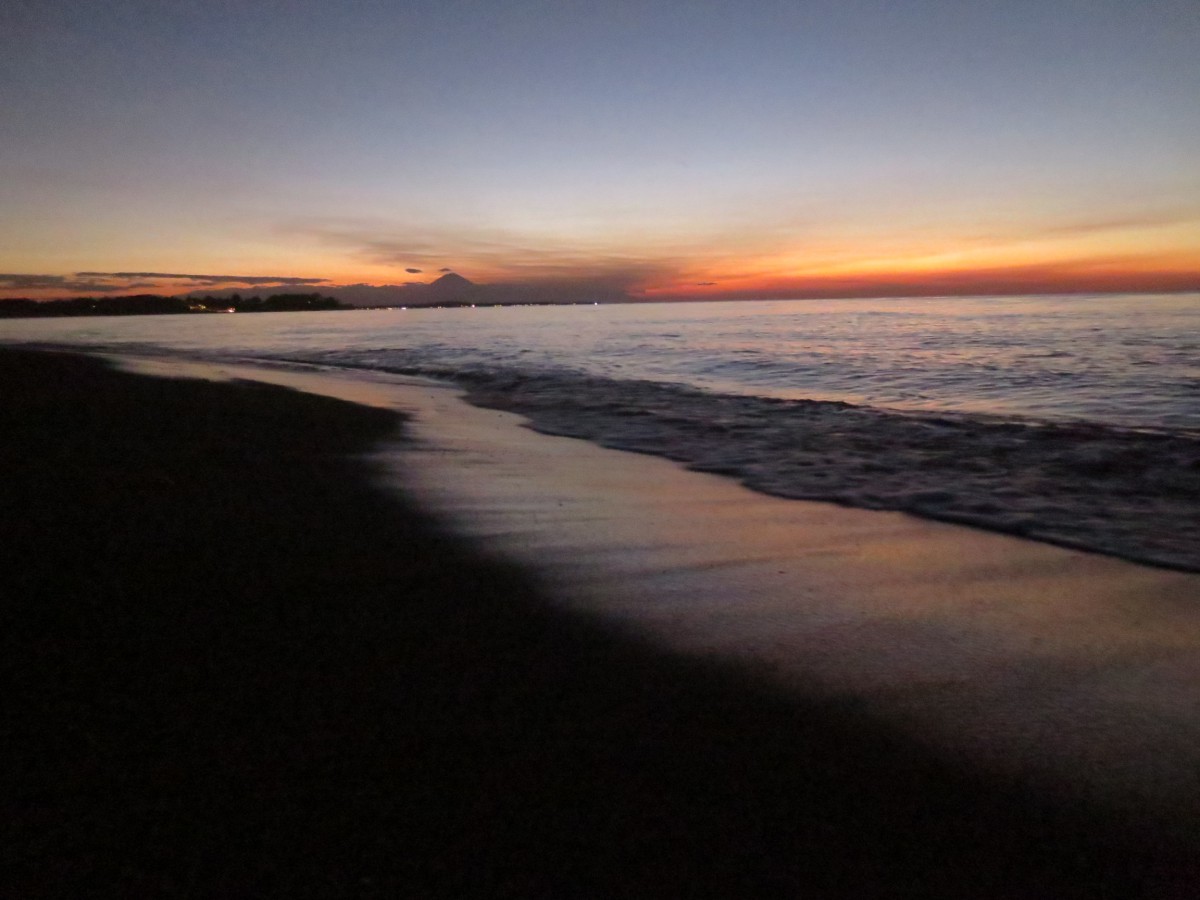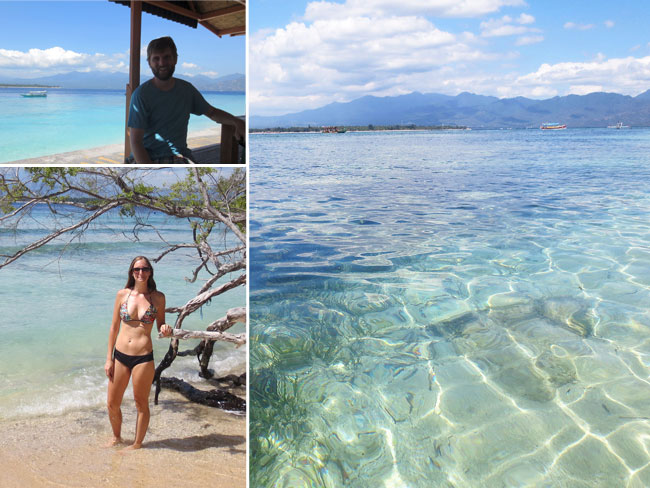Mini escape to the Gili Islands
Bali is distinctly different from her Mother, Indonesia. Born from another father than Sumatra, Papua, Borneo, or even Java or Tenggara next door, Bali was raised observing completely unique cultural and religious rituals than the others–and really, than the rest of the world. Much of the differences between Bali and the other islands, spawn from religious views–where Indonesia is mostly Muslim, Bali is nearly 90% Hindu. Balinese women wear mostly modern clothes, similar to those in the rest of non-Islamic Southeast Asia. However, during holy holidays and religious festivals Balinese woman are adorned in unique traditional clothing; beautiful, tight, lace blouses and long vibrantly colored sarong skirts. Their hair perfectly coiffed, their lips red with rouge. The men in longis and crisp white shirts, with headscarves. Whereas the women of Muslim Indonesia are covered from head to toe in loose draping fabrics.
A little about Indonesia…
Over 18,000 islands make up Indonesia–6,000 of which are inhabited by a total of around 240 million people and 3000 official ethnic groups. Statistics claim 87 percent of the population is Muslim, making Indonsia home to the largest Muslim population in the world.
And so, though Lombok is less than 100 kilometers away, it barely resembles it’s sister so close next door. We had the experience of visiting Lombok over the Islamic holy month of Ramadan. We should have known better.
From the moment we reached solid ground, it was evident. We drove for nearly an hour and a half before we found a single food venue open for business. After our 4-hour sunrise ferry ride, we took note of every hungry minute before we could scarf down breakfast. Throughout several hours driving along the coast, there was barely a roadside stand serving customers. If it weren’t for a few of the busier roads, we would have thought were on a ghost island.
A little about Ramadan…
Ramadan, the ninth month of the Muslim calendar, is an entire month where no Muslim eats or drinks during daylight hours––that’s not a bite of food or drink of water between Sunrise and Sunset. Just think about that for a moment…
Instead, Muslims feast once just before sunrise and once just after sunset. During these times the mosques blast prayers from loudspeakers across the land. Sometimes, like during sunset, this is enchanting and exotic (for a Wisconsin girl like me.)
An American couple I met on the fast boat back to Bali, said they went on a 3 day/2night trek to the summit of Mt Rinjani. They had hired a guide to lead them through the multi day hike. That guide was Muslim, which meant he survived these two 12 hour days, trekking in the tropical heat without food or water. Again, just think about that for a moment...
Our time in Lombok…
Our drive along the coast from Lembar is stunning. We feel like the only foreigners on the island. On a normal day, Lombok is quieter and less developed than Bali, but during Ramadan, much of the island shuts down. Lombok is covered in lush, rolling hills, palm forests and stunning blue coastline.
At one point along the road we notice an abandoned beachfront property. What formally must have been real estate gold is now a concrete skeleton. These days, it appears to be a favorite hangout for local teenagers. We see several groups coming in and out during our brief time exploring the building. Predictably, they ask if we’ll pose in a photo with them.
We spend our first night in a charming Eco resort on the sea, not far from the Bangsal Ferry Terminal. It’s peaceful here, miles from the nearest notable city, down dusty dirt roads. We spend the rest of the day on the lounge chairs near the infinity pool, overlooking an empty beach and warm, calm water. Dinner is pizza and after that, a rousing game of scrabble.
Exhausted from our lack of sleep the previous night, and our 4 AM ferry ride, we pass out, sleeping deeply until early morning prayers blast loudly from mosques in all directions. They each seem to be in a sound system competition.
It’s evident we’ve picked an awkward time to visit Lombok. As we are so near the Gili Islands we decide to head to Gili Meno for a night or two, explore the little island and try the famous snorkeling spots. Since these islands depend on tourism money, and see a larger number of visitors than mainland Lombok, we figured Ramadan wouldn't have as big of a hold here. We were right.
About the Gili Islands…
The Gili Islands are the sort of place that make up island fantasies, screensaver backdrops and the prettiest of postcards–white sand beaches, breezy palms and that blue water you see in photos on the internet you always believed to be photoshopped.
This group of islands is made up of Gili Trawangan (Gili T), Gili Meno and Gili Air; each smaller and less developed the closer the proximity to Lombok. Though there are handfuls of stunning untouched islands off Lombok, these three are by far the most famous. This is likely due to their short distance from Bali and the plentiful transportation options between the three islands and the "mainland."
Gili T, as it’s called, is known as the “party island,” likely because of the number of bars, restaurants, backpacker hostels and affordable beachy bungalows it contains. Gili Meno is famous for it’s beaches and Air for it’s resorts. All three are prime spots for observing underwater life or just lounging the day away while enjoying five star views.
This being a last minute decision, we had few plans. But we were instantly blown away and decided to spend the remainder of our week here. We booked a few nights in a private $20/night bungalow and settled in. First on our agenda was joining a snorkeling tour. Jim had his heart set on seeing Sea Turtles.
This was an easy task with more places on the island advertising snorkelling trips than actual visitors. And so on our first afternoon, just Jim and I, and two boat drivers, who each spoke only a few words of English, stopped at several dive spots surrounding both Gili Meno and Gili T. Our best stop was our first, here we saw several sea turtles and scores of colorful fish.
Our first night we walked to the west side of the island for the sunset, and found a perfect dinner spot with cheap, delicious happy hour cocktails. This part of the island is cheap and chill compared to the more popular eastern coast. This is likely because the beaches on this side contain more sharp coral and the water is not quite as vibrantly hued.
We spent the remainder of our time eating plenty of delicious food, moving from seaside café to seaside café, enjoying the facilities of each; cozy gazebos and lounge chairs. Gili Meno is the perfect spot to relax.
When the time came, I booked a fast boat home so I could arrive before my Friday night classes began, while Jim headed back to Lombok mainland to grab our motorbike and catch the slow ferry back to Bali.
Gili Meno & Lombok Tips..
Transport:
Though there are countless shops selling boat tickets, it’s best to try to the agencies inland and away from the west side of Gili Meno. I was quoted 660,000 rupiahs for a one-way ticket at a shop near the dock, but paid half that at a little agency in the center of the island; for the exact same boat service and seat type. The same goes for booking your tickets from Bali to the islands–shop around!
We brought our rented motorbike over from Bali (see my post detailing the journey to Lombok from Bali here). But Sengiggi, Kuta and other tourist hubs on Lombok offer rentals. Otherwise, you’ll have to use tourist buses, public transport or hire a private driver.
There are no motorized vehicles on the Gili Islands–which definitely adds to the charm. Horse and buggies for hire are found throughout, in case you’re feeling tired or lazy.
There are “island-hopping” transfer boats between the three islands, and to Lombok and Bali. Check with the boat office at the docks for a schedule. Otherwise there’s always the option of hiring private transfer for a much higher price.
Activities:
While it's a pretty great place to do nothing, there are some other activities if you should get bored with that. *Snorkelling gear can be found all over for $6-10 & while we did not dive, we saw shops all over, both on the east and west side. If you don't want to book a tour, rent some gear and check out the waters off the northeast end. *Swim in the clear, warm water! There are countless restaurants with cool beachside gazebos & lounge chairs available for paying customers; buy a lemonade and leave your stuff, while you swim. *Becuase of it's small size, and lack of vehicles, walking around on the islands footpaths is an immensely enjoyable experience.
Accommodation:
Being July and high season, we were paranoid and quickly booked a bungalow on Agoda the night before arriving. This was not necessary. There are countless places to stay peppered throughout the three islands. Unless you’re picky, you can probably wing it.
Food:
We were pleased with the numerous food options. The east side has plenty of beachfront restaurants ranging from luxury to beach shacks. This side of the island had a surprising number of wood burning pizza ovens. For a fancy meal, try Seri Resort, with it’s clean-whitewashed walls and bright blue accents, swanky music, and a perfect view of the sea.
Seafood was more expensive than expected, though again the west side is your best bet for budget options (and sunset views). The center has the largest range of authentic, cheap Indonesian food.







